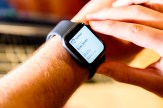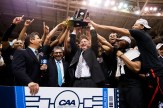Liveblog: RISE showcases university’s research and entrepreneurial spirit
And the winners are…
April 7, 2016 5:51 pm by Matthew McDonald

Photo by Matthew Modoono/Northeastern University
The breadth and depth of Northeastern’s research and entrepreneurial spirit was on full display Thursday at RISE:2016, the university’s Research, Innovation, and Scholarship Expo. Industry leaders judged some 400 projects, which detailed the work of more than 900 Northeastern students and faculty. The judges submitted their ratings and the top award winners were recognized at an afternoon reception in East Village.
“We are very proud of you,” President Joseph E. Aoun said in addressing the award recipients. “I was talking to some of the judges and they were mentioning the passion. Some were talking about the bigger ideas that they saw.”
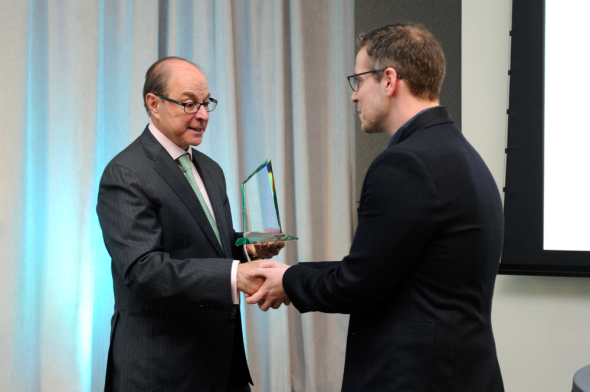
Photo by Matthew Modoono/Northeastern University
And now, here are this year’s award winners:
RISE Awards
Excellence in Research: Mansi Jain: Automated Diagnostic System for Gastric Cancer
Excellence in Innovation: John de la Parra: Biosynthesis of Plant-Derived Pharmaceuticals
Excellence in Scholarship: Sarah Solomon: Housing the Boston Homeless
Greatest Entrepreneurial Potential: Colin Bernardo: 3D Scanning of Neuroanatomical Structures
Graduate Innovator Award: Joshua Martin: Developing Hierarchically Reinforced Composites Vi
Best Video Pitch: Jacob Ganley: Functionalizing Antibodies Using Flow Chemistry
Outstanding Student Research Awards
Computer and Information Sciences
Undergraduate: Keith Harrigian: Anonymity and Gender Inference on Reddit
Graduate: Mansi Jain: Automated Diagnostic System for Gastric Cancer
Engineering and Technology
Undergraduate: Quan Do: A Sensor-Based App for Video Game Play
Graduate: Joshua Martin: Developing Hierarchically Reinforced Composites Vi
Health Sciences
Undergraduate: Alyssa Long: Pharmacy Student Interactions with Minority Groups
Graduate: Julie Goff: Gross Motor Group Effects on Children with ASD
Humanities and Arts
Undergraduate: Sarah Solomon: Housing the Boston Homeless
Graduate: Joseph di Bella: Re-thinking Structure
Physical and Life Sciences
Undergraduate: Joseph Chung: Development of a Fluorescent Western Blot of CFTR
Graduate: John de la Parra: Biosynthesis of Plant-Derived Pharmaceuticals
Social Sciences, Business, and Law
Undergraduate: Amelie Desrosiers: Pathways to Progress
Graduate: Matthew Murry: Attachment and Emotion Perception Across Adulthood
Interdisciplinary Topics
Undergraduate: Shawn Jones: Triton SCUBA Diving Prosthetic
Graduate: Michael Williams: Human in the Loop Debris Collection
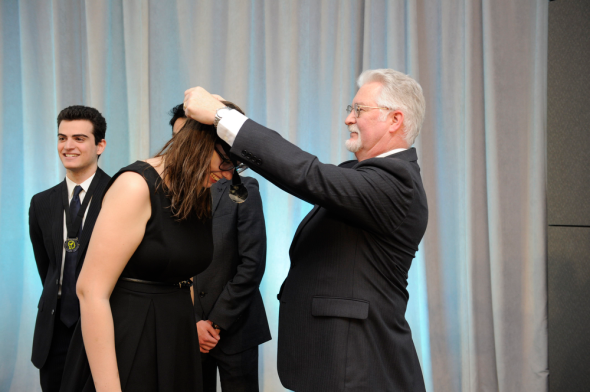
Photo by Matthew Modoono/Northeastern University
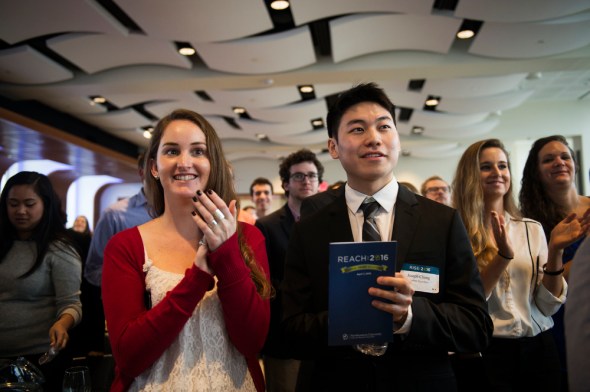
Photo by Adam Glanzman/Northeastern University
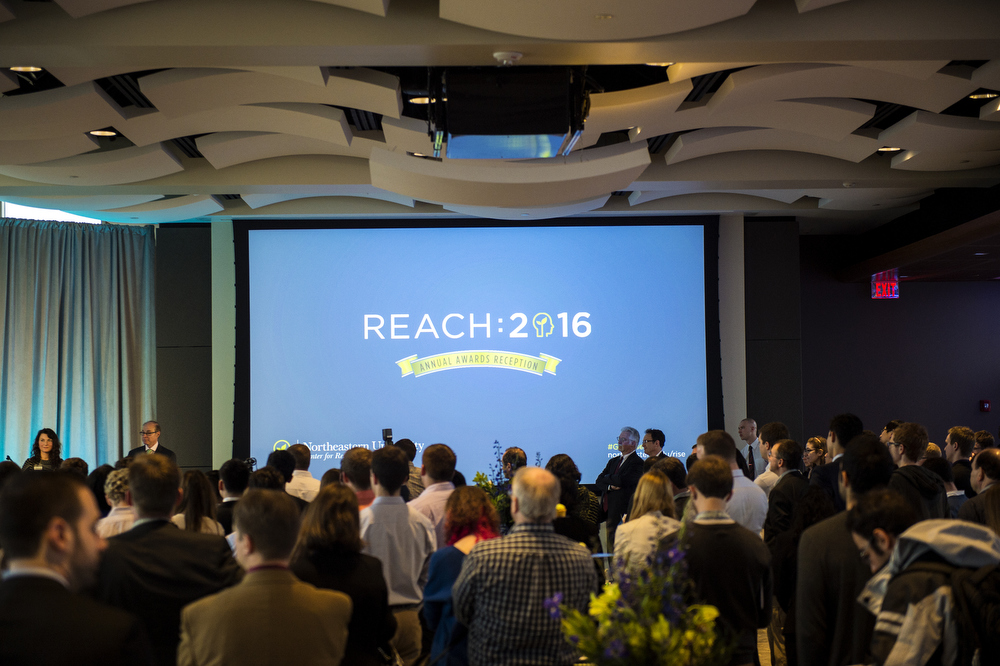
Photo by Adam Glanzman/Northeastern University
Related posts:
- And they’re off
- Faculty, staff, and students recognized for contributions to fields from engineering and literature to physics
- Building businesses piece by piece
- Good things come in small packages
If you’re reading this on your smartphone…
April 7, 2016 4:55 pm by Greg St. Martin
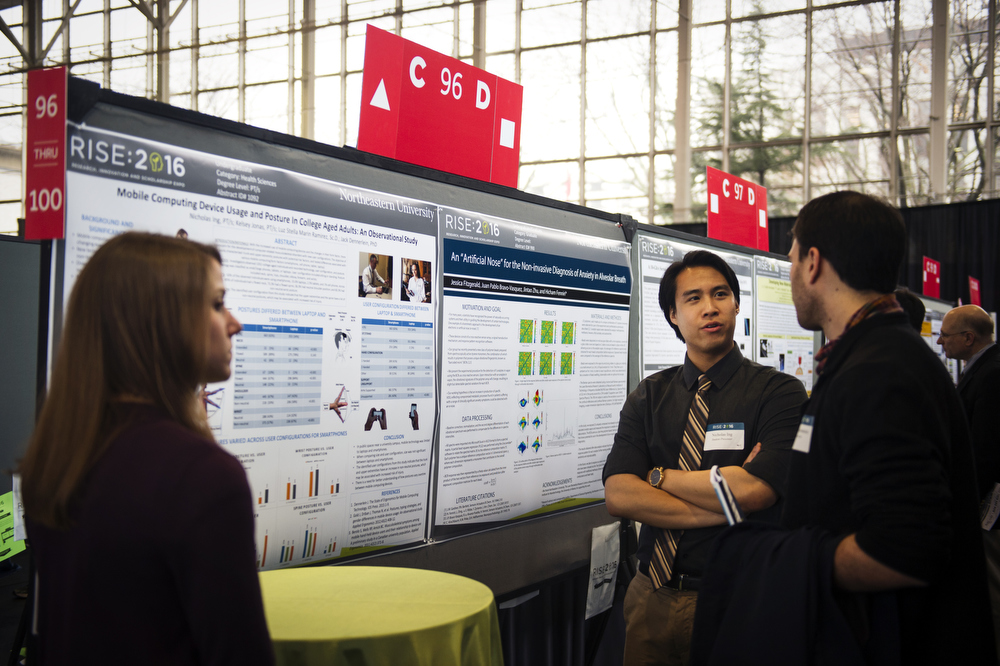
Photo by Adam Glanzman/Northeastern University
Almost everywhere you look nowadays, you’re likely to find someone staring down at a smartphone. At RISE, two Northeastern physical therapy students presented their research on how this practice may impact people’s posture—and possibly lead to musculoskeletal disorders.
For their study, Nicholas Ing, BHS’16, and Kelsey Jonas, BHS’17, observed 1,052 college-aged people in a variety of locations in Boston—including cafes, libraries, student centers, and MBTA stations—and recorded which type of device they were using as well as their posture (including neck, spine, hips, shoulder, elbow, forearm, and wrists), and whether they were sitting or standing. The majority of people were using smartphones (63 percent) or laptops (33.6 percent).
They observed that across devices, 83 percent had a flexed neck and 73 percent had a flexed spine. They also noticed that more than half of the people’s wrists were in a cocked, or non-neutral, position. “All of these put together can, over time, affect your body and potentially cause injuries,” Jonas said. She said the study could lead to future research looking into how this will affect people over time as well as potential health interventions.
Meanwhile, two other physical therapy students—Ranjana Kanungo, BHS’16, and Jeffrey Sanschagrin, BHS’17—presented their research focused on improving rehabilitation for patients with chronic ankle instability using a robotic device developed by their faculty advisor, assistant professor Sheng-Che Yen. The students explained that people with chronic ankle instability walk with a more inverted ankle, thereby predisposing themselves to sprains. The robotic device is driven by air muscles and helps the patient safely restore his normal ankle position while walking.
They first tested the device on healthy patients, and the next step would be to test this on patients with chronic ankle instability. They said it would also improve upon a current rehabilitation intervention that utilizes a balance training board. “It’s interesting to see how our profession will change as more robotics become a part of rehab,” Kanungo said.
RISE, in their own words
April 7, 2016 4:49 pm by Northeastern News
More than 900 innovative and entrepreneurial Northeastern students and faculty took part in RISE:2016. Here, in their own words, a few of these students share their research.
Video by Shirin Mozaffari/Northeastern University
The mindfulness meditation app
April 7, 2016 4:41 pm by Jason Kornwitz
Student-athletes face a unique set of stressors that can work to compromise their overall well-being, according to Peter Ward, PhD’19.
After conducting a comprehensive literature review of the 2010 NCAA GOALS study and others looking at risk factors impacting college athletes, he discovered that it’s not uncommon for them to miss class and spend up to 80 hours per week on sports and academics.
“Student-athletes report more stress than non-athletes in terms of romantic relationships, decreased sleep, and demand of extracurricular activities,” said Ward, a doctoral student in the counseling psychology program who presented his findings at RISE:2016.
To reduce negative health outcomes among college athletes and non-athletes alike, Ward is working with assistant professor Mariya Shikyo to develop a mindfulness meditation app.
The app—titled “Just Be”—is being piloted in four classes this semester, giving 100 students the chance to get in touch with their inner Zen. It comprises eight audio recordings that guide users through as many different exercises, including breathing and body scan meditations.
“Athletic teams often think outside the box when it comes to their training,” Ward said, “and this app can be another tool for them to tackle their stress.”
Before and after disaster
April 7, 2016 4:32 pm by Greg St. Martin
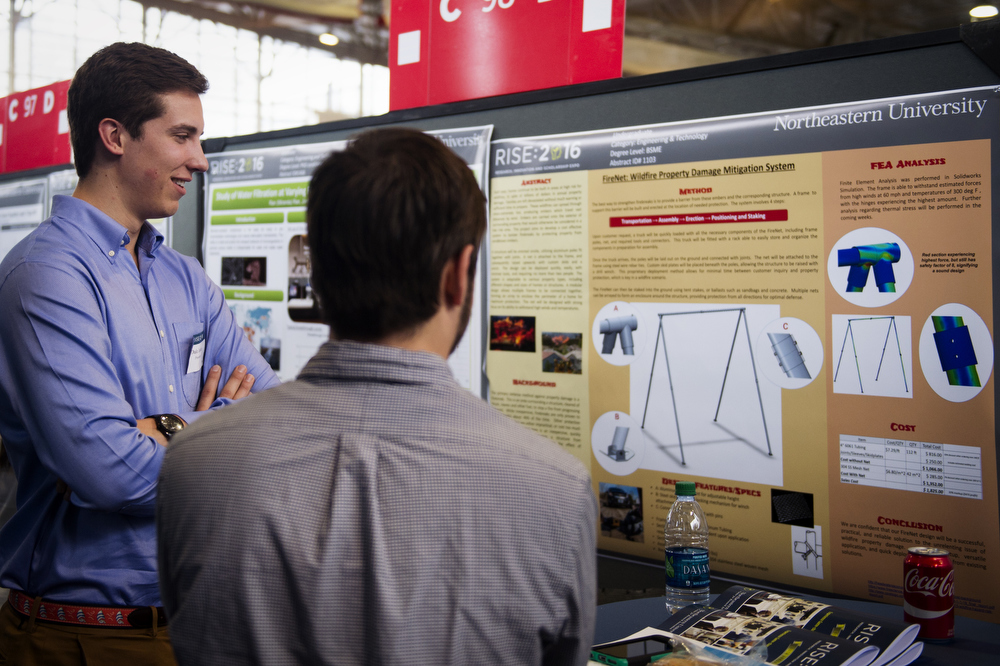
Photo by Adam Glanzman/Northeastern University
For their senior capstone project, four mechanical engineering students—Brian Bernstein, Jonathan Brown, Dale Jordan, and Max Sobel, all E’16—focused on creating a low-cost, quickly deployable solution for helping to mitigate property damage during wildfires. They designed what they’re calling FireNet, a 6-meter-tall structure with aluminum poles as frames and a stainless steel woven mesh net. Once a wildfire breaks out, the idea would be to stake one or more FireNets into the ground in front of buildings to block out embers, which can travel large distances by wind.
Early simulations have shown the frame is able to withstand the force of 60 mph winds and temperatures of 300 degrees Fahrenheit.
Only steps away from this group, graduate student Michael Williams, MS’17, presented his interdisciplinary research team’s work that is focused on optimizing the response to another type of disaster—after the event happens. Specifically, the team of students and faculty is combining mathematical modeling and human-in-the-loop experiments to address how best to collect and clear debris from roads after man-made explosions or natural disasters like earthquakes.
By leveraging the fields of operations research, game design, and computer science, the team is developing a video game in which players are given a network of roads to clear following a disaster. They are tasked with determining the routes private sub-contractors should take to clear the debris—with the goal of minimizing the time it takes to clear the debris while also maximizing the profit gained for each sub-contractor. The goal is to develop a framework for how to best leverage human knowledge and computing to solve complex problems to achieve resilient infrastructure networks.
“The reason this is important is that if a community is destroyed, you want to rebuild it as quickly as possible,” said Williams, adding that such a framework would be particularly valuable for communities that are ravaged by natural disasters on a regular basis.
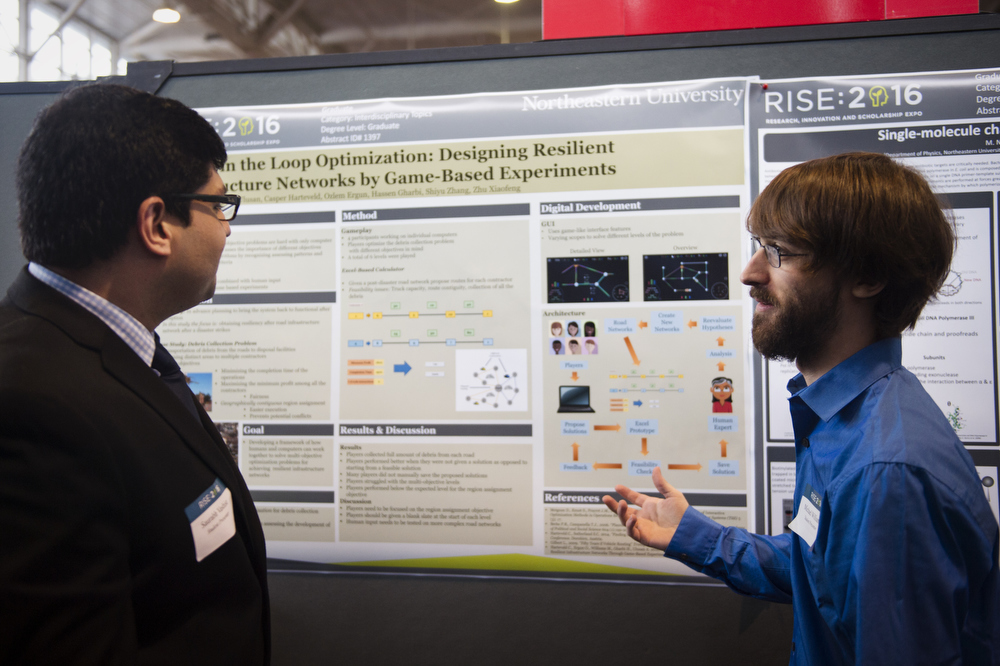
Photo by Adam Glanzman/Northeastern University
Soul of a new machine
April 7, 2016 4:28 pm by Thea Singer
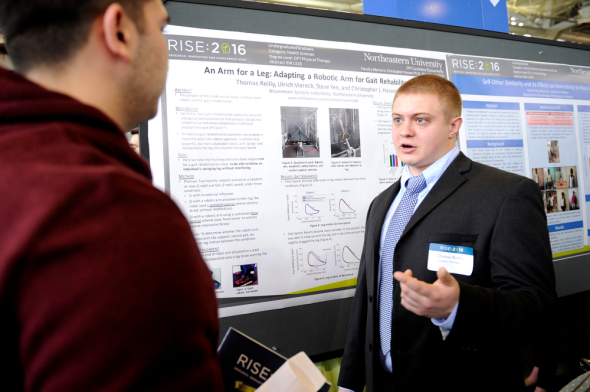
Thomas Reilly, BHS’16, is designing a sensitive robotic arm that can help people who have suffered medical casualties learn to walk again. Photo by Matthew Moodono/Northeastern University
“An arm for a leg.”
No, the line is not part of a bargaining exchange. It’s the catchy title of Thomas Reilly’s research poster at RISE:2016.
Reilly, BHS’16, is devoted to making rehabilitative robots more sensitive and less cumbersome while retaining their strength. To those ends, the fifth-year physical therapy major has designed an electrically-powered robotic arm that can help people who have suffered spinal cord injuries, strokes, and other medical casualties learn to walk again.
The standard robotic offerings, says Reilly, comprise “gigantic metal panels,” or “exoskeletons,” worn on the leg, trunk, and upper extremities. The patient uses the device while on a treadmill and supported by a harness. Reilly’s invention, which also uses a treadmill and harness, comprises a simple robotic arm that attaches to a band on the user’s ankle.
Think mainframe computer transformed into MacBook Air.
“We wanted a robot that could mirror a human physical therapist,” says Reilly. “Sensitivity” is the key word. “The aim was for it to be able to sense when the person was ready to move a leg and to follow that lead with no interference.”
In the initial stages of rehab, Reilly’s robot would do much of the work, guiding the user through a natural heel-to-toe gait. But as the user gained mobility, he or she would become more self-reliant. “The impetus would come from the person, not the robot,” he says.
Related posts:
- It’s a bug’s life
- And they’re off
- Research, entrepreneurship at Northeastern celebrated at RISE:2015
- Professor receives Fulbright award for juvenile arthritis research
The sights and sounds of RISE:2016
April 7, 2016 3:00 pm by Northeastern News
Video by Benjamin Bertsch/Northeastern University
Related posts:
It’s a bug’s life
April 7, 2016 2:47 pm by Thea Singer
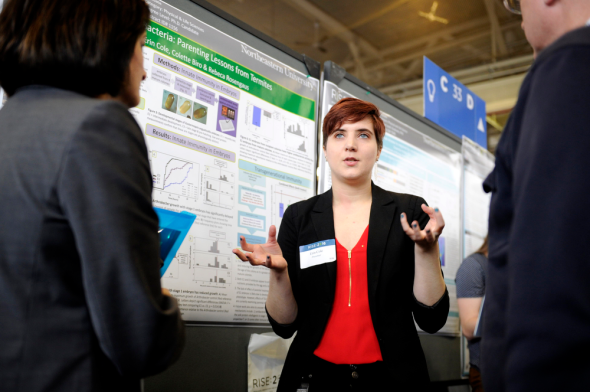
Doctoral student Erin Cole researches how termite eggs cope with bacteria to understand the role of parenting in early development. Photo by Matthew Moodono/Northeastern University
“I study termites,” says Erin Cole, a fourth-year Ph.D. student in the Department of Biology. “I’m not here to tell you how to kill them.”
No, she’s here at RISE:2016 to help us learn from them. Her research, titled “Battling Bacteria: Parenting Lessons from Termites,” explores how the eggs of termites—the progeny—cope with bacteria. Her findings could have broad ecological implications and also provide clues for pest management, perhaps using bacteria to control their spread.
Cole, who specializes in ecology, entomology, and evolutionary biology, is fascinated by these wood-chomping insects. They are extremely social, she says, and despite living in colonies that can number to the hundreds of thousands, they are monogamous and couples share parenting responsibilities of their innumerable young. Fortunately, they generally get help from “worker” termites, members of the largest, most rudimentary caste who, not surprisingly, do all the hard labor.
What would happen, Cole wondered, if workers weren’t available? “On the subway, when someone sneezes, everyone is exposed,” she says. “I wanted to know: Can an egg resist a pathogen alone?”
To find out she isolated eggs at three stages of development and grew bacteria alongside them. The findings surprised her: The stage-one eggs—the newest ones—not only delayed bacteria growth but also reduced the bacteria population. The stage-two and stage-three eggs, however, enhanced the bacteria growth.
What might this mean? It could be that the termite parents lick the new eggs, perhaps depositing some temporary protectant on it, she speculates. Or it could be that the mother puts something inside the egg while it’s being formed. “What makes the nutrients in the egg also makes the immune response,” she says.
Most of us view termites as pests, not guides to childcare. Erin Cole’s continuing research could make us take a second look.
Related posts:
- Soul of a new machine
- Research, entrepreneurship at Northeastern celebrated at RISE:2015
- Researchers’ discovery may explain difficulty in treating Lyme disease
- And they’re off
The perfect pacifier
April 7, 2016 2:30 pm by Joe O’Connell
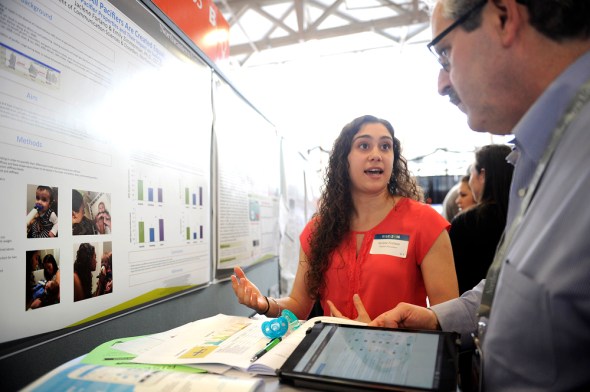
Graduate student Jaclene Forlano sought to find the perfect pacifier. Not just one with a stuffed animal hanging from it to entertain infants, but one that can help pre-term infants develop the sucking skills they need.
Babies begin to develop non-nutritive sucking, or NNS, between the 29th and 32nd week of pregnancy. Infants born prematurely, before NNS can develop, can experience feeding issues. The pacifier serves as a tool for those babies to use to play catch up.
“We really need to support pre-term infants in developing NNS,” Forlano said. “Some of these children have difficulty feeding.”
Under the direction of assistant professor Emily Zimmerman in the Department of Communication Sciences and Disorders, Forlano, a speech pathology student graduating in May, tested six different pacifiers on 16 infants, specifically looking at the pull stiffness and the base of the pacifier that covers the mouth.
But none of the pacifiers have a combination of the two characteristics that could best help pre-term infants effectively improve NNS, she explained.
“We want to take our findings and combine them in an optimal pacifier that just doesn’t seem to be out there,” Forlano said. “A lot of the brands say they are the best but don’t have research to back that up.”
Related posts:
The gamification of rehabilitation
April 7, 2016 1:54 pm by Jason Kornwitz
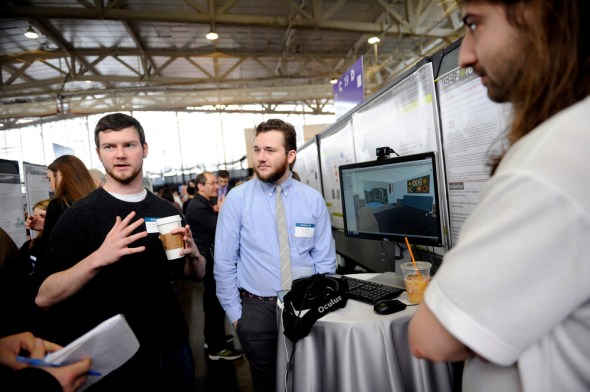
Three student engineers explain how they’re applying the principles of gaming to the process of stroke rehabilitation. Photo by Matthew Modoono.
Peter Scannell, E’16, is one of five student engineers working to harness the power of the Oculus Rift virtual reality headset to help stroke patients overcome hemispatial neglect. Also called unilateral visual inattention or hemi-inattention, it’s a neuropsychological condition preventing stroke victims from perceiving stimuli on one side of their body or environment.
“We want to gamify the process of rehabilitation,” Scannell explained at RISE:2016, where the engineers-in-training demoed a prototype of a game integrating the virtual reality headset and a body motion tracking system.
Here’s how it works: Apply the headset, move your head to locate cabinets and drawers to your left, to your right, and in front of you, and then use your hands to open them.
Said team member Jesses Michel, E’16: “Right now, you can do a lot of useful things with the Oculus Rift, especially in terms of physical therapy and brain exercises.”
Under the direction of Waleed Meleis, an associate professor in the Department of Electrical and Computer Engineering, and Danielle Levac, an assistant professor in the Department of Physical Therapy, Movement, and Rehabilitation Science, the students conducted a needs assessment with physical therapists at the Spaulding Rehabilitation Hospital in Boston. The next step is to conduct a pilot test with a small sample of adults with hemispatial neglect to determine the efficacy of their VR interface.
“The goal is to help make physical therapy for hemispatial neglect more engaging and more applicable,” said Michel.
Good things come in small packages
April 7, 2016 12:24 pm by Joe O’Connell

Juan Lopez, E’17, displays the wind turbine he and his peers developed for RISE:2016. Photo by Matthew Modoono/Northeastern University
Today’s wind turbines are gargantuan structures that require high wind speeds to generate large amounts of energy for consumers.
One group of engineering students presenting at RISE:2016—and featured at the event’s Innovation Alley—wondered, why go big? Why not go small?
Drawing from a past capstone project, Juan Lopez, E’17, and his team developed a scaled-down version of a wind turbine that would be geared toward everyday consumers and utilize slower wind speeds to generate energy using a furling and unfurling method.
“Through our research we determined that the high wind speeds needed to generate the energy output big wind turbines claim are just not common,” said Lopez, a mechanical engineering student. “Our prototype would be for household consumers and generate about 40 percent of a house’s electricity.”
The smaller turbine, which would have about a 30-foot diameter, would operate with winds between three and seven meters-per-second. Once wind speeds get too high, sails on the turbine would furl, decreasing the surface area and preventing the turbine from rotating.
Once a full-scale model of the turbine is built, Lopez said the next step would be to attach a generator to it and start creating energy.
Related posts:
- And they’re off
- Good things come in small packages
- Engineering fair highlights robust undergraduate research opportunities
- Northeastern researcher’s work leads to popular theory bearing his name
And they’re off
April 7, 2016 11:01 am by Northeastern News
The judging is underway at RISE:2016. The doors opened at 10 a.m., and presenters are talking with judges and visiting with expo attendees. Here are a few photos of the early activity.
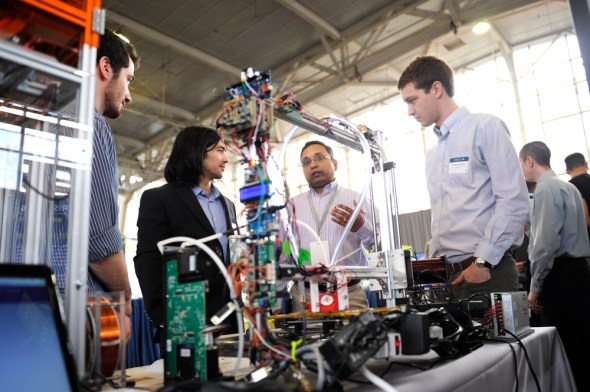
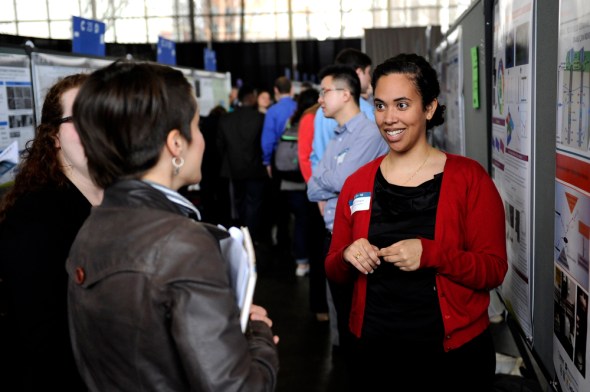
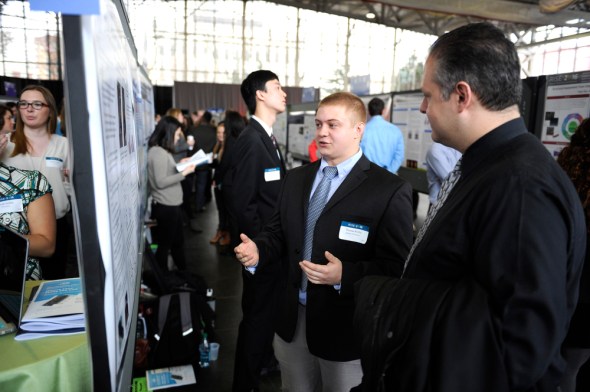

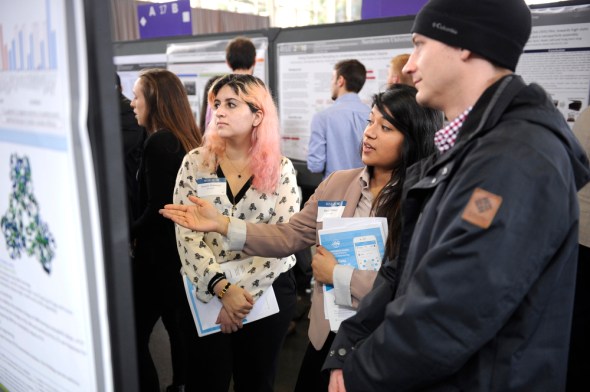
Related posts:
- And the winners are…
- Building businesses piece by piece
- Good things come in small packages
- Northeastern honors community’s highest achievements
RISE and shine
April 7, 2016 8:00 am by Greg St. Martin

Photo by Brooks Canaday/Northeastern University
Today’s the day—RISE:2016, Northeastern’s Research, Innovation, and Scholarship Expo. The annual event showcases the breadth and depth of our students and faculty members’ research and entrepreneurial spirit across many disciplines. We’ll be live blogging with full coverage—including photos and video—throughout the day to share with you participants’ projects, innovations, stories, and much more.
Here’s what you need to know about RISE this year. The expo will be held from 10 a.m. to 2 p.m. in Cabot Cage. There were more than 400 abstract submissions for RISE this year. Nine hundred students and faculty will be participating, and better than 100 industry judges will be reviewing their posters, listening to their pitches, and scoring their video submissions. (This year, for the first time, all RISE participants had to submit a video pitch.)
The expo will be followed by an awards ceremony from 3 to 5 p.m. in East Village. Awards will be given to students in seven categories, and there will also be four RISE Awards for showing excellence in each of the following areas: research, innovation, scholarship, and entrepreneurship. There will be an award for the best video pitch, as well.
Our blog will also feature a compilation of social media posts about RISE from throughout the day, and you can follow RISE on Twitter using #GotResearch.
PAST RISE EVENTS
 |
 |
 |
 |
| RISE:2015 | RISE:2014 | RISE:2013, be there or be square | Apps, co-ops, startups, and global solutions: It’s RISE:2013 |
